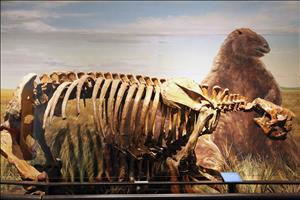On Tuesday, February 14, 1961, while working on a runway at Sea-Tac International Airport, Gordon Simmons of Sellen Construction Company spots bones sticking out of a recently excavated 14-foot-deep hole dug for an anchor for a lighting tower. Digging stops and paleontologists from the Burke Museum are called in to investigate. They find additional bones, eventually totaling about 60 percent of the body of a giant sloth, known as Megalonyx jeffersonii. The extinct animal lived around 12,600 years ago and was the size of a Mini Cooper. A display at the Burke Museum now showcases the discovery, mounted as a complete skeleton.
Old Old Bones
When Simmons finds the bones he stops the dig. Paleontologist Stan Mallory and archeologist Robert Greengo from the Burke Museum are called in to investigate. Over the next week, they work with Elmer White of Western Bridge Company to pull up more bones.
Although the poor conditions -- flooding and collapsing walls in a bog -- make the dig difficult, the scientists extract more than 60 percent of the animal’s body. They do not, however, find the head. Nor do they find any human-made artifacts. But the bones they do dig up are in great shape. Howard A. Coombs, chair of the University of Washington geology department said “You can even see the tiny scars left by muscles. All we have to do to clean them is to put them under the faucet. Usually you have to chip old bones out of hardened soil” (The Seattle Times).
Based on the shape of the 45-inch-wide pelvis, as well as the limb bones and claws, Mallory determined that the bones came from the extinct giant sloth known as Megalonyx jeffersonii. It was the first and only fossil find of these sloths discovered in the state. An older sloth, Megalonyx leptostomus, was found in sediments in Eastern Washington dated around 3.5 million years old.
The History of a Giant Sloth
The Sea-Tac sloth lived and died sometime between 12,600 and 12,760 years ago, soon after the 3,000-foot-thick Puget Lobe of the Cordilleran ice sheet retreated back to the north. A post-glacial habitat of forests, lakes, and bogs provided a diverse food supply for large herbivores such as giant ground sloths. They chewed twigs and leaves with short and stout grinding teeth. They could have used their large claws for hooking branches or possibly for defense.
Megalonyx jeffersonii holds a unique distinction in the annals of paleontology; Vice-President Thomas Jefferson gave the animal its generic epithet in 1797. Jefferson, who had a deep passion for natural history, had received several bones, including the ulna, radius, and claws, from a Colonel John Stewart. The bones had been dug out of saltpeter mine (potassium nitrate, a commonly used fertilizer) in Greenbriar County, Virginia (now West Virginia). In a March 10 speech in Philadelphia before the American Philosophical Society, Jefferson referred to a “large animal of the clawed kind,” which he named Megalonyx or “great-claw” (Jefferson). He thought the claws belonged to a lion or tiger, though one three times larger than a modern variety. Furthermore, Jefferson suggested that the Megalonyx may still be alive in the vast unexplored part of our continent.
Jefferson’s paper was not formally published until 1799. Curiously, a postscript added by Jefferson notes that his initial interpretation of the Megalonyx as a lion was wrong. He had seen a paper written by the great French naturalist Georges Cuvier, which convinced Jefferson that his fossil was akin to a giant tree sloth described by the Frenchman. Jefferson’s ground sloth received its formal name in 1822, when French anatomist Anselme Demarast named it in honor of Jefferson.
At present, the Sea-Tac sloth is on display at the Burke Museum. In order to put together an entire specimen, the missing bones, except for the head, were cast in plaster by Burke employees. The plaster head was donated to the Burke. Based on its size and shape, it is believed to be a cast of a female’s head. No one knows whether the Sea-Tac Sloth is male or female.

